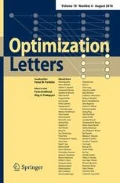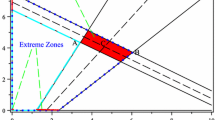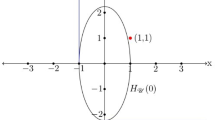Abstract
Interval linear programming (ILP) was introduced in order to deal with linear programming problems with uncertainties that are modelled by ranges of admissible values. Basic tasks in ILP such as calculating the optimal value bounds or set of all possible solutions may be computationally very expensive. However, if some basis stability criterion holds true then the problems becomes much more easy to solve. In this paper, we propose a method for testing basis stability. Even though the method is exponential in the worst case (not surprisingly due to NP-hardness of the problem), it is fast in many cases.
Similar content being viewed by others
References
Alefeld, G., Herzberger, J.: Introduction to interval computations. Academic Press, London (1983)
Beeck, H.: Linear programming with inexact data. Technical report TUM-ISU-7830, Technical University of Munich, Munich (1978)
Gabrel, V., Murat, C., Remli, N.: Linear programming with interval right hand sides. Int. Trans. Oper. Res. 17(3), 397–408 (2010)
Hladík, M.: Optimal value range in interval linear programming. Fuzzy Optim. Decis. Mak. 8(3), 283–294 (2009)
Hladík, M.: Complexity of necessary efficiency in interval linear programming and multiobjective linear programming. Optim. Lett. 6(5), 893–899 (2012)
Jansson, C.: A self-validating method for solving linear programming problems with interval input data. In: Kulisch, U., Stetter, H.J. (eds.) Scientific computation with automatic result verification, Computing Suppl. 6, pp. 33–45. Springer, Wien (1988)
Jansson, C., Rump, S.M.: Rigorous solution of linear programming problems with uncertain data. Z. Oper. Res. 35(2), 87–111 (1991)
Koníčková, J.: Sufficient condition of basis stability of an interval linear programming problem. ZAMM. Z. Angew. Math. Mech. 81(3), 677–678 (2001)
Krawczyk, R.: Fehlerabschätzung bei linearer optimierung. In: Interval Mathematics, LNCS 29, pp. 215–222. Springer, Berlin (1975)
Kuchta, D.: A modification of a solution concept of the linear programming problem with interval coefficients in the constraints. CEJOR Cent. Eur. J. Oper. Res. 16(3), 307–316 (2008)
Lai, K.K., Wang, S.Y., Xu, J.P., Zhu, S.S., Fang, Y.: A class of linear interval programming problems and its application to portfolio selection. IEEE Trans. Fuzzy Syst. 10(6), 698–704 (2002)
Li, Y.P., Huang, G.H., Guo, P., Yang, Z.F., Nie, S.L.: A dual-interval vertex analysis method and its application to environmental decision making under uncertainty. Eur. J. Oper. Res. 200(2), 536–550 (2010)
Machost, B.: Numerische Behandlung des Simplexverfahrens mit intervallanalytischen Methoden. Tech. Rep. 30, Berichte der Gesellschaft für Mathematik und Datenverarbeitung, 54 pages, Bonn (1970)
Moore, R.E., Kearfott, R.B., Cloud, M.J.: Introduction to interval analysis. SIAM, Philadelphia (2009)
Mráz, F.: On infimum of optimal objective function values in interval linear programming. Technical report KAM Series, pp. 96–337, Department of Applied Mathematics, Charles University, Prague (1996)
Mráz, F.: Calculating the exact bounds of optimal values in LP with interval coefficients. Ann. Oper. Res. 81, 51–62 (1998)
Neumaier, A.: Interval methods for systems of equations. Cambridge University Press, Cambridge (1990)
Ning, S., Kearfott, R.B.: A comparison of some methods for solving linear interval equations. SIAM J. Numer. Anal. 34(4), 1289–1305 (1997)
Noghabi, A.S., Mashhadi, H.R., Sadeh, J.: Optimal coordination of directional overcurrent relays considering different network topologies using interval linear programming. IEEE Trans. Power Deliv. 25(3), 1348–1354 (2010)
Oettli, W., Prager, W.: Compatibility of approximate solution of linear equations with given error bounds for coefficients and right-hand sides. Numer. Math. 6, 405–409 (1964)
Poljak, S., Rohn, J.: Checking robust nonsingularity is NP-hard. Math. Control Signals Syst. 6(1), 1–9 (1993)
Rex, G., Rohn, J.: Sufficient conditions for regularity and singularity of interval matrices. SIAM J. Matrix Anal. Appl. 20(2), 437–445 (1998)
Rohn, J.: (1989) Systems of linear interval equations. Linear Algebra Appl. 126(C):39–78
Rohn, J.: Cheap and tight bounds: The recent result by E. Hansen can be made more efficient. Interval Comput. 1993(4), 13–21 (1993)
Rohn, J.: Stability of the optimal basis of a linear program under uncertainty. Oper. Res. Lett. 13(1), 9–12 (1993)
Rohn, J.: A handbook of results on interval linear problems (2005) http://www.cs.cas.cz/rohn/handbook
Rohn, J.: Interval linear programming. In: Fiedler, M et al. (eds.) Linear optimization problems with inexact data, chap. 3, pp. 79–100. Springer, New York (2006)
Rohn, J.: Solvability of systems of interval linear equations and inequalities. In: Fiedler, M. et al. (eds.) Linear optimization problems with inexact data, chap. 2, pp. 35–77. Springer, New York (2006)
Rohn, J.: Forty necessary and sufficient conditions for regularity of interval matrices: A survey. Electron. J. Linear Algebra 18, 500–512 (2009)
Rohn, J.: An improvement of the Bauer-Skeel bounds. Technical Report V-1065, Institute of Computer Science, Academy of Sciences of the Czech Republic, Prague (2010). http://uivtx.cs.cas.cz/rohn/publist/bauerskeel.pdf
Rohn, J., Kreinovich, V.: Computing exact componentwise bounds on solutions of linear systems with interval data is NP-hard. SIAM J. Matrix Anal. Appl. 16(2), 415–420 (1995)
Rohn, J., Kreslová, J.: Linear interval inequalities. Linear Multilinear Algebra 38(1–2), 79–82 (1994)
Rump, S.M.: INTLAB - INTerval LABoratory. In: Csendes, T. (ed.) Developments in reliable computing, pp. 77–104. Kluwer Academic Publishers, Dordrecht (1999). http://www.ti3.tu-harburg.de/rump/
Sengupta, A., Pal, T.K.: Fuzzy Preference Ordering of Interval Numbers in Decision Problems, Studies in Fuzziness and Soft Computing, vol. 238. Springer, Berlin (2009)
Sun, Y., Li, Y., Huang, G.: Development of a fuzzy-queue-based interval linear programming model for municipal solid waste management. Environ. Eng. Sci. 27(6), 451–468 (2010)
Zhou, F., Guo, H.C., Chen, G.X., Huang, G.H.: The interval linear programming: a revisit. J. Environ. Inform. 11(1), 1–10 (2008)
Acknowledgments
The author was partially supported by the Czech Science Foundation Grant P403/12/1947.
Author information
Authors and Affiliations
Corresponding author
Rights and permissions
About this article
Cite this article
Hladík, M. How to determine basis stability in interval linear programming. Optim Lett 8, 375–389 (2014). https://doi.org/10.1007/s11590-012-0589-y
Received:
Accepted:
Published:
Issue Date:
DOI: https://doi.org/10.1007/s11590-012-0589-y




